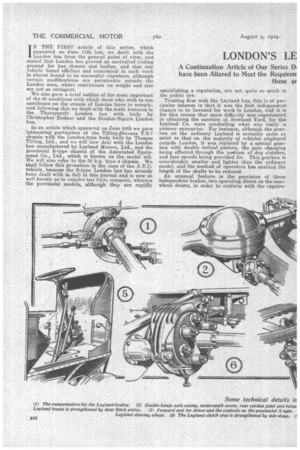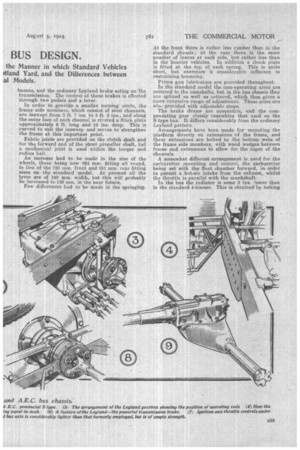LONDON'S LE • BUS DESIGN.
Page 14

Page 15

Page 16

If you've noticed an error in this article please click here to report it so we can fix it.
IN THE FIRST article of this series, which appeared on June 17th last, we dealt with the London bus from the general point of view, and stated that London has proved an unrivalled testing ground for bus chassis and bodies, and that any vehicle found efficient and economical in such work is almost bound to be successful elsewhere, although certain modifications are permissible outside the London area, where restrictions on weight and size are not so stringent.
We also gave a brief outline of the most important of the 65 conditions with which those who wish to run omnibuses on the streets of London have to comply, and following this we dealt with the main features in the Thornycroft London bus with body by Christopher Dodson and the Straker-Squire London bus.
In an article which appeared on June 24th we gave interesting particulars of the Tilling-Stevens T.5.7 chaesis with the London-type body built by Thomas Tilling, Ltd., and we will now deal with the London bus manufactured by Leyland Motors, Ltd., and the provincial S-type chassis of the Associated Equipment Co., Ltd., which is known as the model 503. We will also refer to the 35 h.p. type 4 chassis. We 'shall follow this procedure in the case of the A.E.O. vehicle, because the S-type London bus has already been dealt with in full in this journal and is now so well known as to require but little comment, whereas the provincial models, althotigh timy are rapidly
establishing a reputation, are not quite so much in the public eye.
Treating first with the Leyland Lus, this is of particular interest in that it was the first independent chassis to be licensed for work in London, and it is for this reason that more difficulty was experienced in obtaining the sanction of Scotland Yard, for the Leyland Co. were conducting what was really a. pioneer enterprise. For instance, although the gearbox on the ordinary Leyland is certainly quite as quiet as that on the majority of vehicles employed outside London, it was replaced by a special gearbox with double helical pinions, the .ear changing being effected through the medium of dog clutches, and four speeds being provided for. This gearbox is considerably smaller and lighter than the ordinary model, and the method of operation has enabled the length of the shafts to be reduced.
An unusual feature is the provision of three independent brakes, two operating direct on the rearwheel drums, in order to conform with the require ituents, and the ordinary Leyland brake acting on The transmission. The control of these brakes is effected through two pedals and a lever.
In order to provide a smaller turning circle, the frame side members, which consist of steel channels, are inswept from 3 ft. 7 ins, to 3 ft. 2 ins., and along the outer face of each channel is riveted a flitch plate approximately 6 ft. long and 10 ins. deep. This is curved to suit the insweep and serves to strengthen the frame at this important point. • Fabric joints are provided on the clutch shaft and for the forward end of the short propeller shaft, hut a mechanical joint is used within the torque and radius ball.
An increase had to be made in the size of the wheels, these being now 881 mm. fitting all round, in lieu of the 720 mm. front and .381 mm. rear fitting sizes on the standard model. At present all the tyres are of 120 mm. width, but this will probably be increased to 130 mm. in the near future.
Few differences had to be made in the springing. At the front there is rather less 'camber than in the standard chassis.; at the rear there is the same number of leaves at each side, but rather less than in the heavier vehicles. In addition a cheek plate is fitted at the top of each spring. This is quite short, but exercises a considerable influence in restraining bouncing.
Prima gun lubricators are provided throughout.
In the standard model the cam-operating arms are cottered to the camshafts, but in the bus chassis they are splined as well as cottered, which thus gives a more extensive range of adjustment. These arms are also provided with adjustable stops.
The brake drums are concentric, and the compensating gear closely resembles that used on the S-type bus. It differs considerably from the ordinary Leyland pattern. Arrangements have been made for mounting the platform directly on extensions of the frame, and these extensions are bolted to the bottom webs of the frame side members, with wood wedges between frame and extensions to allow for the taper of the channels.
A somewhat different arrangement is used for the carburetter mounting and control, the carburetter being set with the float chamber forward, in order to permit a hot-air intake from the exhaust, whilst the throttle is parallel with the crankshaft. In the bus the radiator is some 3 ins. !ower than in the standard 4-tonner. This is obtained by bolting the radiator direct to the frame members, instead of tarrying it on trunnion mountings. A tribute to the work which has to be done in London traffic is shown by the extra stay fitted at each side of the clutch stop. The acceierator pedal is carried between the clutch pedal and one brake pedal, and stops are provided on both brake ped.als to keep them in line with the clutch pedal, the shaft of the last-named having jaw stops.
Alterations have, of course, had to be made to the engine bearer brackets, owing to the frame insweep. Dialing with the rear axle, this has been especially designed for the bus. The axle easing is of cast steel sloped cup to the spring brackets. The final drive is by overhead worm in lieu of double reduction gearing, and the whole axle is very much lighter than usual. We noted that Thaekray spring washers are fitted to all fork connections, bait, as a matter of fact, these are employed on all Leyland vehicles,
A saving in weight has also been .effected in the ease of the wheels, but there is never any need to do anything drastic, such as drilling the frame, and this is a definite contradiction to any rumours to the contrary.
The drive to the lighting dynamo is somewhat unusual, being by V belt from a pulley on the centre of the clutch cover.
As showing the saving in weight which has been effected all round, that of the standard chassis is 3 tons 11 cwt., whilst the bus chassis weighs 3 tons
4 cwt.' being made up of rear axle I ton 12 cwt. 3 qrs., front axle I ton 11 cwt. 1 qr. The bus complete averages 4 tons 14 ewe
The turning eirele is 55 ft., and with, an engine "speed of 1,000 r.p.m. the respective gear ratios give road speeds as follow :—Top, 7.25 to 1, speed 17 m.p.h. ; third, 12 to 1, speed 10.2 ; second, 20.75 to 1, speed 6; first, 37.1 to I, speed a3; reverse, 48 to 1, speed The following dimensions will be of interest : the wheelbase is 15 ft. 10 ins. ; overall length 21 ft. 7 ins. ; height to top of frame, with 32-cwt. load, 3 ft.
So far as the bodies are concerned, these are mostly built by Clleistopher Dodson, Ltd., and have been dealt with in previous articles.
We will now proceed with the details of the two A.E.C. provincial models. The chief difference betle.een these chassis, and the London S-type is that they are equipped with spur-tooth gearboxes, with internal-tooth engagement for top gear and sliding pinions for the others, whereas the London type has a three-speed chain-driven gearbox with dog engagement of the gears.
So far as the bee' provincial models are concerned the differences between them are. not radical. One has a 3,5 h.p. engine with single-plate clutch of the B34
dry type and a wheelbase of 14 ft. 11 ins., whilst the other has a 5-type 45 h.p. engine, a Ferodo-faced cone clutch and a wheelbase of 15 ft. 5i ins., the gearing remaining the same, although' in both types a choice of final ratios is given.
The actual gear ratios, of course, depend upon the ratio of the final drive. Taking the less powerful
vehicle first, with a ei-to-1 ratio' the respective vehicle speeds at 1,000 r.p.m. are 13.3, 7.86, 4.62 and' 2.61; with a worm gear ratio of Si to I the speeds become 14.92, 8.82, 5.2 and 2.93. The large model has a third allowable worm gear ratio of 7i to 1, which gives speeds of 16.97, 10.05, 5.92 arid 3.33.
The rear axles are all of the horizontal, doublebanjo type with tubes pressed in, as distinct from the pot-type used on the London model. The worm is carried underneath. The usual type of torque member is fitted, but in this case it is bolted to the worm casing, because difficulties occur in connection with holding it to the banjo. This torque member is much longer than in the London vehicle. The brake drums are eaeh some 2 ins, larger in diameter, being 16 ins. and 22 ins, respectively, with
width of A ins. This also has been increased from 21. ins.
Reverting to the gearbox, another change in this is the fitting of the selector gear at the bottom instead of in the top half of the box.
Self-centring universal joints of the Hardy type are employed for the cluteh shaft, whilst larger couplings, with roller bearings, similar to those used in the lorry, are employed for the propeller shaft. The springing is slightly heavier on the provincial models, and the tyres are 1,050 mm. for 881 ram. fitting, all round, as used on the London type. The driver is positioned at the side of the, engine in the manner with which we are all familiar.
A small improvement is the fitting of the slowrunning adjustment on the . engine sideboard at the left, where it is more ace.esSible. Another alteration is the employment of a spur-pinion differential, the chief advantage of this being the ease of cutting gears. Dust covers are also provided for the brake drums. The height to the top of the frame is 2 ft. 81 and the chassis weights are as follow :—Type 4 chassis, 3 tons 3 cwt..; front axle weight, 1 ton 10 cwt. 3 qrs. ; rear axle weight, 1 ton 12 cwt. 1 'qr. Type 503, chassis weight. 3 tons 10 cwt. ; front axle weight, I ton 16 cwt. ; rear axle weight, 1 ton 14 cwt. Overall lengths are: 25 ft. Si ins. and 26 ft. 3i ins. respectively. The arrangement of the driver's seat at the side of the engine has been found to increase the length of the body space by 3 ft. 6 ins., without adding to the overall length. So far as the bodies are concerned, these necessarily vary according to provincial requirements, and cannot be dealt with in detail.






























